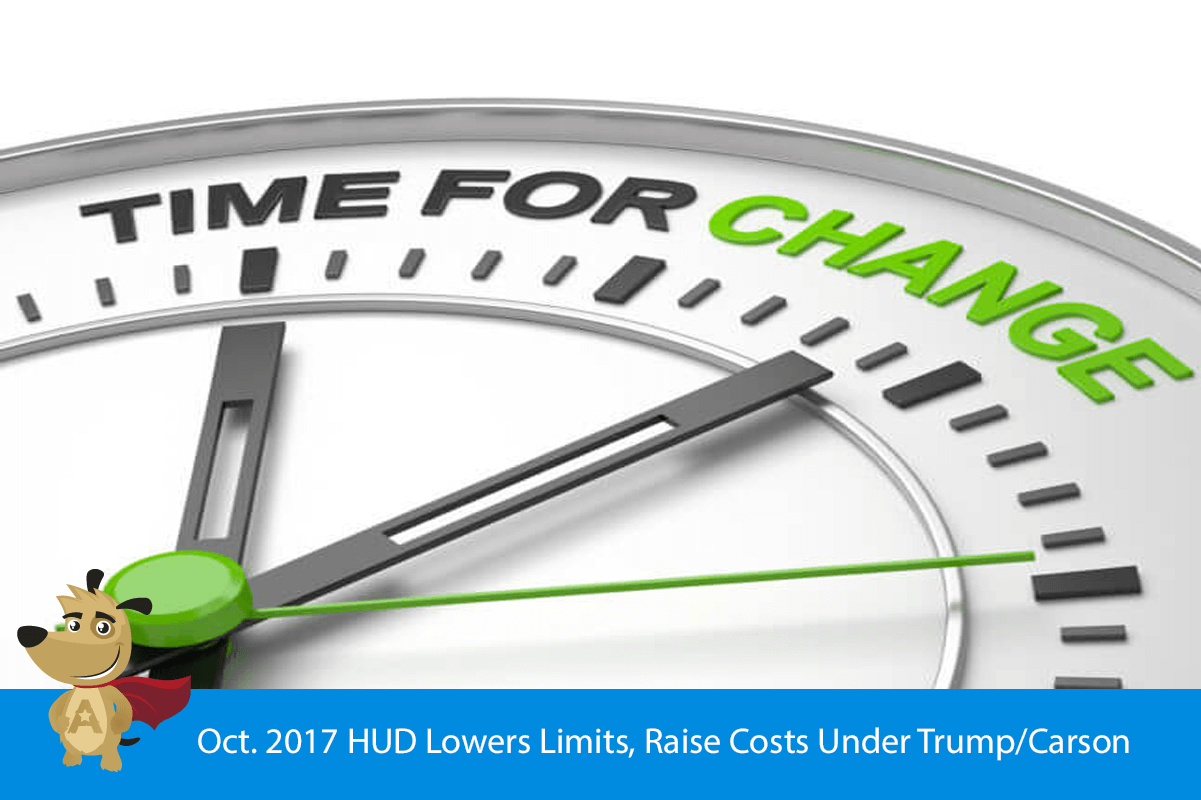
America’s #1 Rated Reverse Lender*

 |
ARLO™REVERSE MORTGAGE
ASSISTANT |
HUD Lowers Limits, Raise Costs Under Trump/Carson
 |
Michael G. Branson, CEO of All Reverse Mortgage, Inc., and moderator of ARLO™, has 45 years of experience in the mortgage banking industry. He has devoted the past 20 years to reverse mortgages exclusively. (License: NMLS# 14040) |
 |
All Reverse Mortgage's editing process includes rigorous fact-checking led by industry experts to ensure all content is accurate and current. This article has been reviewed, edited, and fact-checked by Cliff Auerswald, President and co-creator of ARLO™. (License: NMLS# 14041) |
In our recent article dated July 26, 2017, we indicated that a new administration in Washington marks a time of uncertainty and uneasiness as people try to guess what the new policies will be. The announcements made by HUD today answered some of those questions with regard to the Home Equity Conversion Mortgage program.
Lenders had been hearing bits and pieces of welcome news over the past months of possible condominium approval changes and changes to come for non-borrowing spouses so when it was announced that HUD was issuing a major Mortgagee Letter with changes to the program, at first lenders and borrowers alike were excited.
But as the announcement delivery approached, there were none of the usual drips of the things to come. Most of the time, many in the industry were already aware of the impending changes and there was very little “news” by the time the actual announcement came but this announcement took many lenders, insiders and even those at HUD offices by surprise.

The Mortgagee Letter release by HUD today, ML 2017-12 said nothing of condo project approvals or of non-borrowing spouses but rather declared that in a move necessary to enable FHA to continue to endorse the ongoing HECM loan program, changes were needed which would raise the initial mortgage insurance premiums for many, lower the annual renewal for all and lower the amounts borrowers would receive under the program starting with all new Case Numbers assigned on October 2, 2017 and after.
The first change borrowers will notice is the change to the Initial Mortgage Insurance Premium and the Annual Renewal. For some borrowers, this just got a lot more expensive while for others, it actually represents a big savings.
Borrowers who needed more than 60% of their initial proceeds under the program had to pay an initial premium of 2.5% of the maximum claim amount, which is the property value, purchase price (if applicable) or the HUD lending limit, whichever is less. This change would include all borrowers taking funds that equaled more than 60% of the amount available under the program to pay off existing loans and those using a reverse mortgage to purchase a new home.
But all borrowers currently pay 1.25% of the outstanding balance for the annual mortgage insurance renewal and that will drop to .5% so all borrowers will receive a drop in the annual renewal rate. The borrowers who will not like the initial change would be the borrowers who utilize less than 60% of their initial Principal Limit (or total loan available under the reverse mortgage) in the first 12 months and now will go from a .5% Initial Mortgage Insurance Premium (IMIP) to 2.0%.
The second and more visible change that all borrowers will immediately see is that reduction in the amount of cash that borrowers receive as a percentage of the value of the home. HUD achieved this with two changes. The biggest change is that HUD lowered the 5% floor down to 3% and now rates as low as 3.125% will start to negatively affect proceeds with this change and the deduction in the amount received will increase as the rate climbs.
What does that mean for you? Interest rates have always been one of the factors that determine how much money you can receive but there was a “floor” of roughly 5% which meant that as long as the Effective Rate was 5% or less, all borrowers received the maximum amount available under the program.
Rates have been down for so long now that they have stayed below the floor for many years and all borrowers were receiving the maximum amounts available for their ages. This will no longer be the case as Effective Rates are over 3% and therefore all rate variations will affect loan amounts borrowers receive in the future.
We’ve done the math and invite you to compare these pending changes below:
| AGE | OLD PLF | AGE | NEW PLF | % CHANGE |
| 62 | 0.524 | 62 | 0.410 | 11.40% |
| 63 | 0.530 | 63 | 0.416 | 11.40% |
| 64 | 0.536 | 64 | 0.423 | 11.30% |
| 65 | 0.542 | 65 | 0.430 | 11.20% |
| 66 | 0.549 | 66 | 0.438 | 11.10% |
| 67 | 0.556 | 67 | 0.445 | 11.10% |
| 68 | 0.562 | 68 | 0.453 | 10.90% |
| 69 | 0.569 | 69 | 0.461 | 10.80% |
| 70 | 0.576 | 70 | 0.465 | 11.10% |
| 71 | 0.583 | 71 | 0.465 | 11.80% |
| 72 | 0.591 | 72 | 0.467 | 12.40% |
| 73 | 0.599 | 73 | 0.475 | 12.40% |
| 74 | 0.606 | 74 | 0.483 | 12.30% |
| 75 | 0.614 | 75 | 0.492 | 12.20% |
| 76 | 0.622 | 76 | 0.498 | 12.40% |
| 77 | 0.631 | 77 | 0.508 | 12.30% |
| 78 | 0.640 | 78 | 0.518 | 12.20% |
| 79 | 0.648 | 79 | 0.523 | 12.50% |
| 80 | 0.657 | 80 | 0.534 | 12.30% |
| 81 | 0.665 | 81 | 0.545 | 12.00% |
| 82 | 0.674 | 82 | 0.556 | 11.80% |
| 83 | 0.682 | 83 | 0.567 | 11.50% |
| 84 | 0.690 | 84 | 0.579 | 11.10% |
| 85 | 0.699 | 85 | 0.591 | 10.80% |
| 86 | 0.709 | 86 | 0.603 | 10.60% |
| 87 | 0.719 | 87 | 0.616 | 10.30% |
| 88 | 0.729 | 88 | 0.626 | 10.30% |
| 89 | 0.739 | 89 | 0.640 | 9.90% |
| 90 | 0.750 | 90 | 0.653 | 9.70% |
| 91 | 0.750 | 91 | 0.667 | 8.30% |
| 92 | 0.750 | 92 | 0.682 | 6.80% |
| 93 | 0.750 | 93 | 0.697 | 5.30% |
| 94 | 0.750 | 94 | 0.712 | 3.80% |
| 95 | 0.750 | 95 | 0.727 | 2.30% |
| 96 | 0.750 | 96 | 0.734 | 1.60% |
| 97 | 0.750 | 97 | 0.740 | 1.00% |
| 98 | 0.750 | 98 | 0.740 | 1.00% |
| 99 | 0.750 | 99 | 0.740 | 1.00% |
Example Using 5.0% Expected Rate
E.g., Age 70, Home Value $250,000
Old PLF 57.6% = $144,000 Available
NEW PLF 46.5% = $116,250 Available
PLF Difference $27,750
Not only did HUD lower the floor, but they also lowered the Principal Limit Factors for most borrowers. So even at the lower floor, most borrowers also received a lowered factor which will lower the amount they receive further still. The bottom line? Borrowers will be much more greatly affected by the interest rates quoted to them and will be able to see those differences right from the start with the differences in the bottom line availability in funds. This will also mean that the numbers that borrowers receive from different lenders are more likely going to have a greater degree of difference from lender to lender and program to program.
The bottom line is that for borrowers who have to take all or a large portion of the money available in the early years (those with loans to pay off or are using the loan to purchase a home), the initial costs will actually be reduced, but so will the amount of money available to them. For borrowers who take 60% or less of the funds available in the first year, the initial costs will rise from the previous program parameters. All groups will see the MIP renewal drop by .75% on the outstanding balance each year so for every $100,000 of outstanding balance, they will save $750.00 each year in mortgage insurance renewal premiums. For a borrower with a $300,000 outstanding balance, That’s $2,250 per year saved so many borrowers who use their loans should see the MIP costs come in lower overall or about equal out over the years whereas borrowers who only planned to use their lines in emergencies might rethink their plans with the higher initial costs.
All new borrowers will see the total amount available to them decrease depending on borrower age and interest rate. Borrowers who wish to avoid the lower loan amounts and higher initial costs must get their loan started at the old parameters which means they must have their counseling completed, loan applications in to their lender and the case number ordered by the lender before October 2nd when the new rules go into effect. For borrowers in states like CA with a mandatory 7 day cooling off period in which the lender may not by law order a case number for 7 days, borrowers have even less time to react if they want to proceed under the old parameters but have not yet completed their counseling (7 day period does not include the day of counseling so it really becomes 8). It does not give borrowers who have been sitting on the fence a lot of advance notice but if they do choose to proceed, they do have an opportunity to lock in the old parameters if they act without further delay.
All Reverse Mortgage® is an Award-Winning HUD Approved Direct Lender celebrating over a decade of excellence.
You can still lock in your current limit by getting your case assignment prior to Oct. 2. Case assignments require a signed application and counseling certificate returned to our offices no later than Friday September 29th!
If you’re ready to take the next step start your application here or speak to one of our knowledgeable experts by calling Toll Free (800) 565-1722
Highest A+ Exemplary Rating awarded by the BBB
with Independent Consumer Review of 5/5 STARS

BBB Grade: A+ (97%)


 Michael G. Branson
Michael G. Branson Cliff Auerswald
Cliff Auerswald

Have a Question About Reverse Mortgages?
Over 2000 of your questions answered by ARLO™
Ask your question now!